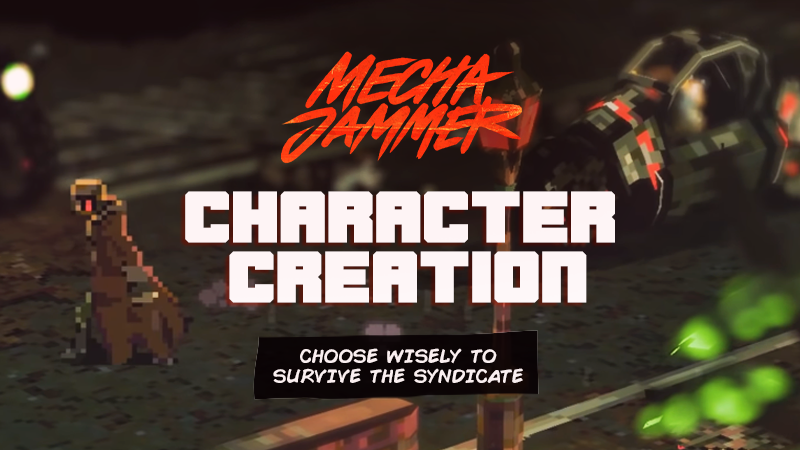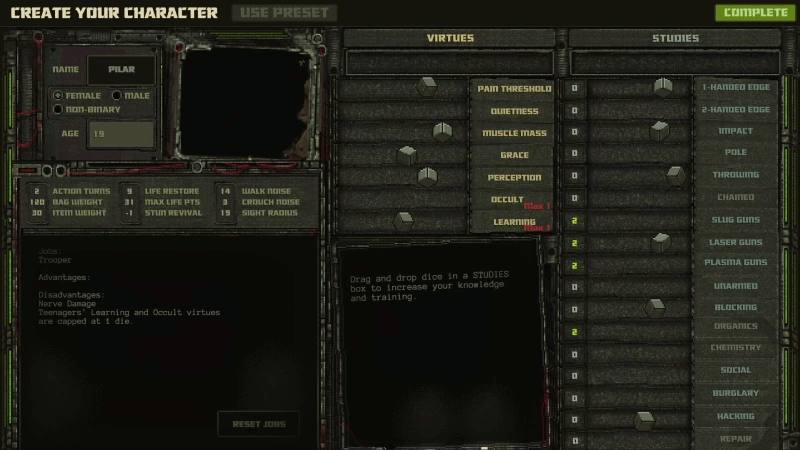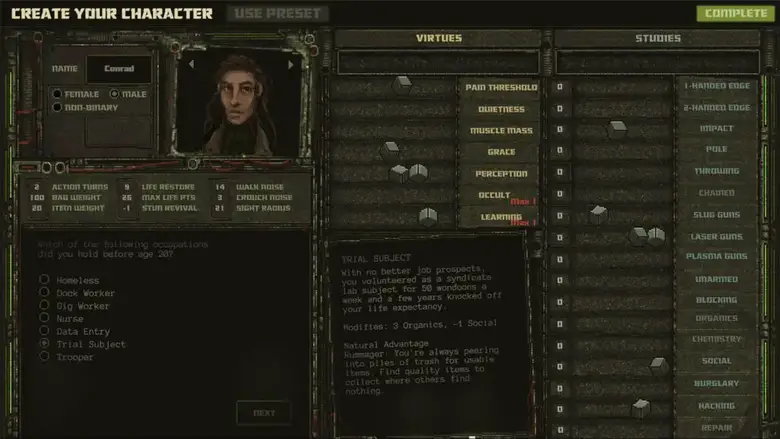gaussgunner
Arcane
It still is, isn't it?

























Mechajammer — Creating your character
Choose who you want to be and if that person has a hope in hell of escaping Calitana.

In Mechajammer your first course of action will be to decide who you are and what skills you believe will help you survive Calitana.

Build your own backstory by selecting multiple answers such as how your birth was labeled via 'kits', occupations you held at an earlier stage in your life, side effects of jobs, and so forth.
Mechajammer allows you options of approaching situations using stealth or blasting your way through enemies. You need to determine which tactics will work best for your desired outcome. Your chosen stats and traits will play a role in whether the odds are on your side.
By placing dice in chosen slots you can select Virtues such as Perception, Pain Threshold, Grace, and more. Each Virtue offers bonuses, enhancing areas that will benefit your playstyle.

Studies let you pick skills to complete your character build. Do you want to be good at hacking and using a harpoon gun? Or be able to charm those you meet to manipulate situations in your favour? There are multiple Studies to choose from and combinations to hone.
Choose wisely and good luck out there...















10 TURNS INTERVIEW WITH MECHAJAMMER DEVS

“When you want to know how things really work, study them when they’re coming apart.”
― William Gibson,
The first time I saw Escape From New York, my initial thought was “What the f**k!” and the second one, more elaborated, was “this is so fu****ng cool!” (well, at that time, I was not so polite just I am now…).
The truth was that, after watching that fantastic movie, my opinions about it were, let’s say, a bit confused. A part of me was convinced that “living in a future like that would have been great“, but the other part, the sane one, thought that living with a life expectancy of a fly was not so… amazing.
The point was exactly this, the movie provoked a strong contradiction in my emotions but, instead of trying to solve it, I simply decided to live it, in my dreams or in my nightmares.
It was 1981, John Carpenter was my new messiah, and I was one of the happiest nerd in the world.
Blood, gratuitous violence, memorable lines and, above all, a bad and surly lead character, a “dead on arrival” who had nothing to lose but also nothing to gain. Undoubtedly, Escape from New York is still one of the main reasons why I’m very proud for being a 80s kid.
Why I’m talking about this movie, are you wondering? Quite simple, because the setting and, partially, the mood of Mechajammer it’s almost the same. Not by chance, Escape from New York is one of the sources of inspiration specifically declared by the devs. So if you plan to try the demo of this little gem, it could be a good idea to watch first our beloved Jena Plissken back in action!

1st Turn) Your Studio is small, but this is not – for sure – your first game, so what have you learned from your previous works, especially from Serpent in the Staglands?
Yeah we keep it cozy, it’s the two of us doing the design and game production, but we have some wonderful assistance from our composer Kevin Balke, who’s generously helped us for nearly 8 years now, and some voice work now and then from the great Caleb Merrick.
Serpent was a fun exploration of making something atmospheric. I think Baldur’s Gate was the first game we played together when we started dating (that multiplayer was just a joy to set up like 10 years ago), and while we love turn based games, we didn’t know what we could add to that genre at the time, and instead wanted to play around with world building and more of that RTS-style gameplay.
It was hard but exciting to work on, especially with the quick deadline we had for it. We learned a lot about a pipeline that works for us development wise, and certainly improved our knowledge on how to build these projects.
2nd Turn) First there was “Copper Dreams”, then Kickstarter’s campaign, and finally Mechajammer. Now, the question is how has your project changed since the beginning? I mean, it isn’t only a matter of name change, I guess.
The main thing that we’ve iterated on over the development cycle is the combat system. Our original concept for the project involved integrating these cool sensory mechanics and simulation-aspects into the turn-based model in a fluid, organic way. The initial project had a sort of Grandia-esque turns bar so we get some time-simulation in, but as we implemented more systems we found that it was too nebulous for the combat we were going for.
To give it a more crunchy feel, we changed actions to play out over ‘ticks’ of time, had actions be composed of multiple turns, and prompted those to play out immediately instead of queuing them. It’s a similar idea to the original concept but without the abstraction of the timeline bar. It also let us get more of those immersive-sim elements that can be based on familiarity with reality that abstract tabletop rules.
The story has undergone some small improvements, but overall the project has stayed true to the original vision.

3rd Turn) Playing the demo, one of the things that impress me more is the combat system. Even if it can be considered turn-based, it is so peculiar that, if I had to choose a word that best represents it, I would say “frenetic”! Can you explain to us how it works and which have been your inspirations in this regard?
Combat begins when someone hears or sees you, and you enter turn mode, where the game world will only move while you are moving or doing an action. (You can enter this at any point as well, which is helpful for stealth situations). All your actions take a number of turns to prep, execute and recover from, which is affected by your stats, environmental modifier, and ailments of buffs you have at the time. Enemies follow the same rules, creating a system of overlapping turns that are simultaneous, but not necessarily executing on the same turn. This means you can have an edge if you know your prep time is quick and an enemy is slower, or if a grenade is heading your way and you want to move a tile away, but it also means if you’re hit mid-turn you’ll have to wait through some interruption turns until your action can complete.

4th Turn) What do you think If I tell you “You touch me, he dies. If you’re not in the air in thirty seconds, he dies. You come back in, he dies. Twenty seconds…”?
I think Plissken’s about to have a rough day.
5th Turn) Luckily in Mechajammer, you don’t have to save the world, and you are not a damned “chosen one”. Your main goal is to escape from the devastated world you live in. An egoistic yet realistic goal. Does this mean that the story of your game will lack epic?
We really enjoy subtle world building, especially in a CRPG, and for a story we wanted to reflect that with something more grounded. The story of the player and their compatriots is meant to be relatable, you’re not a hero and you’re not a villain, you’re just fighting for a better future for yourself and your friends.

6th Turn) Let’s talk about the art style. At a first glance the keyword seems to be “nostalgia”, but, if you look at it carefully, you’ll see pixel-art wisely mixed with 2D and 3D components. Something really fascinating, but, sometimes, to be honest, also a bit confusing. Do you plan to further refine this aspect?
There’s certainly a line between abstraction and clarity, and that’s something we’re tweaking as the city gets finished up. The environment is (generally) a wall of grunge, but readability of the playing field is, of course, important, we don’t want to use the hex-tiles as too much of a crutch. We like pixel art because it leaves something up to the imagination, the viewer can make those visuals their own, that fits a tabletop-inspired campaign feeling nicely.
7th Turn) What does Mechajammer owe to games like Fallout and Deus Ex?
I mean Fallout 1, as far as converting tabletop to computer, is probably the sexiest crpg ever made. It’s got it all in a very accessible and flashy package, the tone was perfect, brilliant sound effects, and the quest was compacted and snappy in a way that could come straight from a DM. Isometric-wise you have something like Dark Sun Shattered Lands that ticks all the boxes for what the formula will have, but Brian Fargo’s team was visionary in the execution of Fallout 1 and changed the iso-RPG landscape, it’s hard not to look up to something like that.
The problem with taking inspiration from Fallout 1 is it’s been done (and done, and done…). There’s definitely room for growth in the CRPG genre, we saw that cut short in the 90s with the dawn of more 3d, story talky games with RPG elements. For Mechajammer, we tried to re-think what tabletop-like features we’d like to see in an RPG. We lean more wargaming when we play, we’re here to kill as many orcs as we can until we die, and drink along the way. What we wanted was to create what we think an action film should be as a turn-based RPG, with setting inspiration drawn from our own experiences moving around urban environments in the US.
Related, as far as Deus Ex goes, we really love the sensory systems it used and they were definitely an influence from the beginning of the project, especially as the catalyst of getting less abstract with how turns played out and making them more of a simulation.
Deus Ex’s atmosphere of a grimy, accessible New York was awesome to explore. So often in sci-fi environments, you get sterile corridors, the standard-asset looking metallic mapped walls, and shiny pipes. Deus Ex was grungy, the streets and citizens were a mess, it was great, and feels fresh if you boot it up today. We like that grittiness because it’s how cities really feel, and despite Mechajammer taking place off-world, people occupy these places and making them lived in and appropriately disgusting and familiar is important to us.

8th Turn) I tried the demo and, in my humble opinion, it somehow failed to give the exact perception of how deep are the RPG features of your game. I mean, the creation of your main character seems to be so deep and articulated, with many original virtues (a sort of perk) and studies (best known as skills), but during the short demo, you can’t do much more than fighting and killing. Even the answers during the dialogues seem to be not so important. So my question is: why have you decided to release a demo so “combat-focused”? Do you plan to release a new version of the demo where we will be able to play a wider section of the game and, even more important, drive the super-cool motorcycle of the trailer?
We’d certainly like to have folks check out the variety of vehicle options on the streets, sweet bikes and faster cars especially. Something some testers have suggested was a turn-based model for combat-driving, which we implemented and works wonderfully, so we’d love to put that into a follow-up demo at some point before release for people to have street-fights in cars.
9th Turn) Any plan for mod supporting?
No plans in the works as of now. The 3d maps are similar to something like Nox’s ‘true sight’ as Westwood called it, but with 3d geometry. This way there is no camera management in the environment, the player’s line-of-sight is sort of cut through, but at the cost of being somewhat demanding on a pipeline level for the maps. There isn’t a drag & drop version of something like that for consumers to play with regrettably, it’s a pretty custom process.

10th Turn) Mechajammer is in full development for many years. Can you tell us if you plan to release the game in E.A. and, eventually, when?
We’ll be releasing a complete game, details to come soon!
11th Turn) Before leaving you, just a bonus question. Which is the latest turn-based game you’ve played or still playing?
Grandia remaster on the Switch. Art filter was unnerving.
Thank you very much for your time. We will continue to follow your project. For any other information please visit the official website, while here the Steam page.
I backed this on Kickstarter including the books and shit, I've since forgotten the deets used to back it and can't find a Kickstarter email (this game was the first and last thing I ever kickstarted) Anyway of checking with the developers outside of Kickstarter in order to claim my beta access and goodies when they're ready?
"Chicken chaser? Chicken chaser!"
Every day this torment with random gifs. Please, what kind of game is it? Demo told me nothing.
















Three Hand Harry commentary video
Hello!
We consolidated some gameplay from the city into some general overview stuff on navigation. Three Hand Harry is a punk, and Hannah gives a few recommendations on how to greet your neighbors on Calitana:
We're nearing ready to summon you all for some larger game area testing. Prior to this we're finishing some focused improvements on:
enemy / companion AI
NPCs have various ranges of how stupid they are, from attack-flee-wander to actively searching for you through shadows like the terminator. We're finding a nice balanced in-between feel for the median encounter and companion.
UI upgrades
Reflect some of these AI visual updates (noise indicators, suppression meters are louder, etc.)
Sneaking
Some gameplay tweaks to make things easier, based off feedback. Sneaking will now happen anytime you are holding shift and click to move somewhere, or click on yourself to just crouch. Sometimes you just want to duck behind a box, but then you want to run after that, and don't want to enter a sneak mode where you're committed to a slow quiet movement. Much more versatile, and easy to remember, shift for shifty.
Adapting to Chaos
The way the game is laid out and [very] open-ended, it ranges from infiltration focused to very casual exploration and driving. The gangs react to you(r violence) in logical ways — gangs friendly to ones you've attacked will turn hostile to you, and ones also against them open up as allegiances. But what about everything else? There's a city of laborers and citizens at the disposal of syndicates, the gangs, and the newcomer: you.
Knowing how most tabletop sessions go, and most games, we needed reactivity for setting the sandbox on fire. With perpetual saving, we also wanted your actions to have enough consequence to be considered (permanent) decisions, but enough leeway to also have some freedom to experiment. Killing a gang boss is cut and dry, but what about everything else?
There are syndicates to steal from, gangs to conquer, drug dens to bust for property keys, and a whole lot more that are inevitable threats. One of the avoidable things you can do in the game is beat the crap out of all the citizens and laborers. They aren’t terribly easy to pummel on accident (you’re welcome, as you’ll find out), but if your going around and convincing hordes of them to join you there’s going to be consequences.
Like the 13 gangs, Calitana itself has a meter to determine its current threat level. For the gangs, you'll usually cross the line on being able to ally with a gang if you kill their agent, or enough of their laborers/patrols. Likewise for the city meter, the civilians in the city are MFI’s laborers, and too many disappearing is going to raise some flags, or guns, in this case.
The stability of the relationship between the civilian laborers, gangs and syndicates of Calitana is pretty shaky at best. As we’ve said, it’s a pot ready to boil over. Someone just needs to turn up the heat. Driving waves of civilians to your violent bidding is enough to raise some eyebrows of the city administrators.
Threat levels can ease with time until it hits a new grade. As the city’s threat level rises, the civilian crowds thin out. Feeling threatened on top of an already dead-end existence, you tip them over the edge, and the denizens band together to form more small-time gangs in the streets. More bodies, more rats, and more MFI patrols.
This is manageable for the player, but resource management can get tighter when your usual peaceful streets are full of enemies to avoid or waste ammo on. Not is all at a loss though. Paying some heavy tribute to The Faith syndicate will replenish civilians back to an indoctrinated state, dropping the Threat level, and giving them a new lease on life.

what ho chicken
























